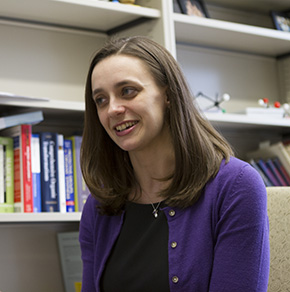A news alert on Laura Wysocki’s phone woke her up on Oct. 8. Big news always seems to do that.
The alert set off a stream of e-mails to colleagues and friends.
“I called my parents to tell them the news,” she said.
It was on that day that Dr. Eric Betzig, one of Wysocki’s colleagues at the Janelia Research Campus of the Howard Hughes Medical Institute, would share the 2014 Nobel Prize in chemistry.
 Big news, indeed.
Big news, indeed.
This isn’t a hello-in-the-hallway kind of relationship; it’s seriously collaborative. Betzig and Wysocki are co-authors on a recent paper (along with four others, including Wysocki’s post-doctorate advisor Luke Lavis), and Wysocki made small contributions to the work that eventually led to Betzig’s Nobel Prize.
Wysocki’s work centers on the synthesis and study of fluorescent dye derivatives, which aid the study of chemical processes by illuminating those processes, i.e. allowing them to be more easily seen.
Super-resolution microscopy, which won the Nobel Prize, allows scientists to observe processes in living cells. Imagine fluorescent dyes as the flashlight in that process.
Betzig wanted small-molecule fluorescent dyes that would work in his microscope and Wysocki and Lavis had the expertise to begin designing the molecule for that application.
“Eric was involved in the research, taking the images himself to see how our compounds would stack up to the state-of-the-art in the field,” she said. “Having the support of colleagues like Eric will certainly strengthen the argument for dye synthesis as an important field of study.”
It was the type of collaboration seen often in science that leads to great discoveries in the lab at Janelia, where she still serves as a visiting scientist, and in the classroom at Wabash.
“The biggest feeling I had was a sense of pride for the intensely collaborative research that we do at Janelia,” Wysocki explained. “The close environment shared by scientists of all disciplines opens up conversations that spark research projects, and now a Nobel Prize.”
The best part is that the award and the connection has sparked many conversations about her work and Wysocki has reveled in the opportunity.
“I started class (last Wednesday) by asking if anyone else had a totally unexpected, amazing, life-changing event happen to them that day, or if it was just me,” she laughed. “It really is incredible. I’ve had lively conversations all week with colleagues and students – scientists and non-scientists alike – who wanted to know all about super-resolution microscopy. I even heard from excited alumni who discovered the connection. It is so rewarding to feel that kind of energy for science in the Wabash community.”
Use the link below to listen to a podcast featuring Professor Wysocki.